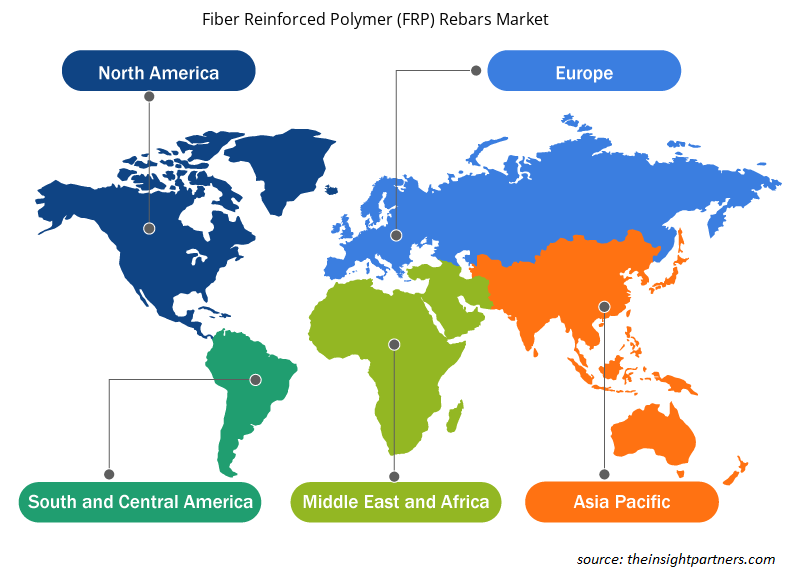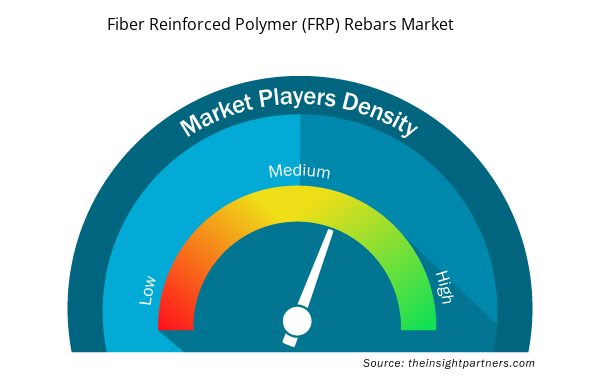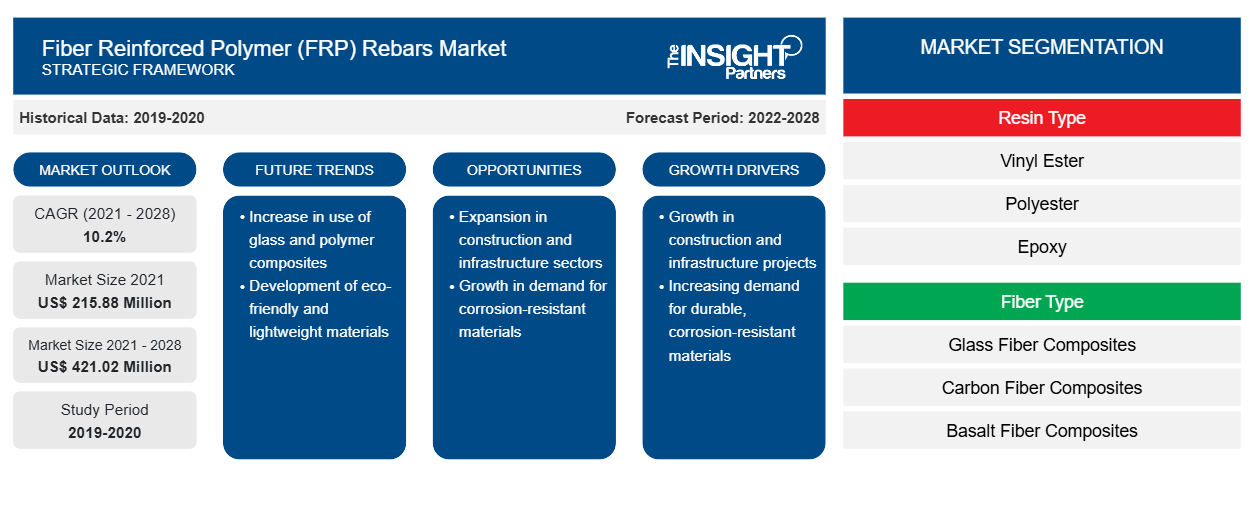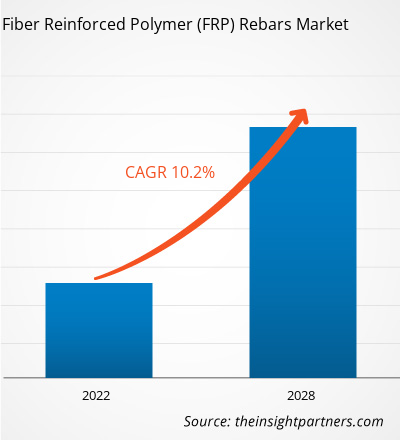Se espera que el mercado de barras de refuerzo de polímero reforzado con fibra (FRP) crezca de US$ 215,88 millones en 2021 a US$ 421,02 millones en 2028; se estima que crecerá a una CAGR del 10,2% entre 2022 y 2028.
Como el hormigón es resistente a la compresión y débil a la tensión, normalmente se lo refuerza para crear un material de construcción que sea resistente a la tensión y la compresión. Este refuerzo se compone tradicionalmente de acero debido a su bajo coste, alta resistencia y alta elasticidad. Sin embargo, la corrosión del acero podría costar a los gobiernos y a los propietarios de activos miles de millones de dólares en costes de mantenimiento para sustituir o reparar infraestructuras antiguas. Existen pocas alternativas a los materiales de refuerzo del hormigón que se puedan utilizar para prevenir la corrosión. Por ejemplo, algunos fabricantes ofrecen barras de refuerzo de acero inoxidable; sin embargo, las barras de refuerzo de polímero reforzado con fibra pueden servir como una alternativa no corrosiva a las barras de refuerzo de acero convencionales para el refuerzo del hormigón. Estas barras de refuerzo de FRP se fabrican con la combinación de una matriz de polímero con fibras de vidrio, carbono o basalto. Estos materiales no se oxidan, son mucho más ligeros que el acero, no transmiten calor y son casi cuatro veces más resistentes a la tensión. La capacidad anticorrosión hace que el polímero reforzado con fibra sea la mejor alternativa para diversas aplicaciones de construcción, como muros de contención, muelles, embarcaderos, muelles, cajones, cubiertas, mamparos, pilotes, canales, plataformas marinas, piscinas y acuarios.
Además, en aplicaciones sensibles a los efectos electromagnéticos, las propiedades no conductoras del vidrio y del polímero de las barras de refuerzo de FRP no transmiten corriente, no atraen rayos ni interfieren con el funcionamiento de dispositivos eléctricos cercanos. Eso hace que el polímero reforzado con fibra sea una alternativa más segura al acero en plantas de fundición de aluminio y cobre, torres de aeropuertos, plantas de energía nuclear, estructuras militares especializadas, torres de transmisión eléctrica y telefónica, pozos de registro que contienen equipos eléctricos o telefónicos y hospitales con equipos de resonancia magnética (MRI).
Personalice este informe según sus necesidades
Obtendrá personalización en cualquier informe, sin cargo, incluidas partes de este informe o análisis a nivel de país, paquete de datos de Excel, así como también grandes ofertas y descuentos para empresas emergentes y universidades.
- Obtenga las principales tendencias clave del mercado de este informe.Esta muestra GRATUITA incluirá análisis de datos, desde tendencias del mercado hasta estimaciones y pronósticos.
Perspectivas del mercado
Las crecientes actividades de construcción impulsan el crecimiento del mercado de barras de refuerzo de polímero reforzado con fibra (PRFV)
La industria de la construcción es uno de los principales contribuyentes al desarrollo económico en todo el mundo. Está floreciendo rápidamente debido al creciente apoyo gubernamental al desarrollo de infraestructura en todo el mundo. Por ejemplo, India planeó gastar US$ 1,4 billones en infraestructura a través del Programa Nacional de Infraestructura de 2019 a 2023. En este programa, el gobierno ha incluido infraestructuras como energía, puentes, represas, carreteras y desarrollo de infraestructura urbana. Debido a sus ventajosas propiedades materiales, como alta resistencia, tolerancia a las heladas y sales de deshielo y tiempos de instalación cortos con mínima interferencia del tráfico, los polímeros reforzados con fibra han madurado para convertirse en valiosos materiales de construcción sustitutos para estructuras de puentes. Se espera que estas iniciativas de los gobiernos de diferentes países impulsen el crecimiento del mercado de barras de refuerzo de polímero reforzado con fibra (FRP).
Información sobre los tipos de resina
Según el tipo de resina, el mercado mundial de varillas de refuerzo de polímero reforzado con fibra (FRP) se segmenta en éster de vinilo, poliéster, epoxi y otros. En 2021, el segmento de éster de vinilo tuvo la mayor participación de mercado. Las resinas de éster de vinilo tienen alta resistencia; alta resistencia a la corrosión, combustibles, productos químicos o vapores; y ofrecen tenacidad mecánica. Tienen gran durabilidad, resistencia al calor y alta resistencia a la elongación por tracción. Esta resina se puede impregnar con fibra de vidrio corta o fibra de carbono para producir varillas de refuerzo de FRP. La mayoría de los fabricantes de varillas de refuerzo de polímero reforzado con fibra utilizan resina de éster de vinilo. La rentabilidad del éster de vinilo ha impulsado el crecimiento del segmento.
Owens Corning; KODIAC Fiberglass Rebar; MARSHALL COMPOSITE TECHNOLOGIES, LLC; TUF-BAR; Armastek USA; Pultron Composites; FiRep Inc.; PULTRALL, Inc.; Schock Bauteile GmbH; y Dextra Group se encuentran entre los principales actores que operan en el mercado global de barras de refuerzo de polímero reforzado con fibra (PRFV). Los principales actores adoptan estrategias como fusiones y adquisiciones y lanzamientos de productos para expandir su presencia geográfica y su clientela. Por ejemplo, Pultron Composites estableció una asociación con Saudi Aramco, la principal compañía petrolera de Arabia Saudita, para aumentar sus instalaciones de producción de barras de refuerzo de polímero reforzado con fibra de vidrio (PRFV) en el país.
Barras de refuerzo de polímero reforzado con fibra de vidrio (FRP)
Perspectivas regionales del mercado de barras de refuerzo de polímero reforzado con fibra (FRP)
Los analistas de Insight Partners explicaron en detalle las tendencias y los factores regionales que influyen en el mercado de varillas de refuerzo de polímero reforzado con fibra (FRP) durante el período de pronóstico. Esta sección también analiza los segmentos y la geografía del mercado de varillas de refuerzo de polímero reforzado con fibra (FRP) en América del Norte, Europa, Asia Pacífico, Oriente Medio y África, y América del Sur y Central.

- Obtenga datos regionales específicos para el mercado de barras de refuerzo de polímero reforzado con fibra (FRP)
Alcance del informe de mercado de barras de refuerzo de polímero reforzado con fibra (FRP)
| Atributo del informe | Detalles |
|---|---|
| Tamaño del mercado en 2021 | US$ 215,88 millones |
| Tamaño del mercado en 2028 | US$ 421,02 millones |
| CAGR global (2021-2028) | 10,2% |
| Datos históricos | 2019-2020 |
| Período de pronóstico | 2022-2028 |
| Segmentos cubiertos | Por tipo de resina
|
| Regiones y países cubiertos | América del norte
|
| Líderes del mercado y perfiles de empresas clave |
|
Densidad de los actores del mercado de barras de refuerzo de polímero reforzado con fibra (FRP): comprensión de su impacto en la dinámica empresarial
El mercado de barras de refuerzo de polímero reforzado con fibra (FRP) está creciendo rápidamente, impulsado por la creciente demanda de los usuarios finales debido a factores como la evolución de las preferencias de los consumidores, los avances tecnológicos y una mayor conciencia de los beneficios del producto. A medida que aumenta la demanda, las empresas amplían sus ofertas, innovan para satisfacer las necesidades de los consumidores y aprovechan las tendencias emergentes, lo que impulsa aún más el crecimiento del mercado.
La densidad de actores del mercado se refiere a la distribución de las empresas o firmas que operan dentro de un mercado o industria en particular. Indica cuántos competidores (actores del mercado) están presentes en un espacio de mercado determinado en relación con su tamaño o valor total de mercado.
Las principales empresas que operan en el mercado de barras de refuerzo de polímero reforzado con fibra (FRP) son:
- Owens Corning
- Barras de refuerzo de fibra de vidrio KODIAC
- TECNOLOGÍAS COMPUESTAS MARSHALL, LLC.
- Barra de tuf
- Armastek Estados Unidos
Descargo de responsabilidad : Las empresas enumeradas anteriormente no están clasificadas en ningún orden particular.

- Obtenga una descripción general de los principales actores clave del mercado de barras de refuerzo de polímero reforzado con fibra (FRP)
Informe Destacado
- Tendencias progresivas en la industria de barras de refuerzo de polímero reforzado con fibra (FRP) para ayudar a los actores a desarrollar estrategias efectivas a largo plazo
- Estrategias de crecimiento empresarial adoptadas por las empresas para asegurar el crecimiento en los mercados desarrollados y en desarrollo
- Análisis cuantitativo del mercado mundial de varillas de refuerzo de polímero reforzado con fibra (FRP) de 2022 a 2028
- Estimación de la demanda de barras de refuerzo de polímero reforzado con fibra (PRFV)
- Análisis de Porter para ilustrar la eficacia de los compradores y proveedores que operan en la industria para predecir el crecimiento del mercado
- Desarrollos recientes para comprender el escenario competitivo del mercado y la demanda de barras de refuerzo de polímero reforzado con fibra (FRP)
- Tendencias y perspectivas del mercado y factores que impulsan y restringen el crecimiento del mercado global de barras de refuerzo de polímero reforzado con fibra (FRP)
- Comprender las estrategias que sustentan el interés comercial con respecto al crecimiento del mercado global de barras de refuerzo de polímero reforzado con fibra (FRP), lo que ayuda en el proceso de toma de decisiones
- Tamaño del mercado mundial de barras de refuerzo de polímero reforzado con fibra (FRP) en varios nodos del mercado
- Descripción detallada y segmentación del mercado global de barras de refuerzo de polímero reforzado con fibra (FRP) y su dinámica industrial
- Tamaño del mercado mundial de barras de refuerzo de polímero reforzado con fibra (FRP) en varias regiones con oportunidades de crecimiento prometedoras
El "Análisis del mercado de barras de refuerzo de polímero reforzado con fibra (FRP) hasta 2028" es un estudio especializado y profundo de la industria de productos químicos y materiales, que se centra en el análisis de tendencias del mercado de barras de refuerzo de polímero reforzado con fibra (FRP). El informe tiene como objetivo proporcionar una descripción general del mercado con una segmentación detallada. El mercado de barras de refuerzo de polímero reforzado con fibra (FRP) está segmentado en tipo de resina, tipo de fibra, aplicación y geografía. Según el tipo de resina, el mercado está segmentado en éster de vinilo, poliéster, epoxi y otros. Según el tipo de fibra, el mercado está segmentado en compuestos de fibra de vidrio, compuestos de fibra de carbono y compuestos de fibra de basalto. Según la aplicación, el mercado está segmentado en puentes y construcción de carreteras, estructuras marinas y frentes de agua, plantas de tratamiento de agua y otros. Según la geografía, el mercado está segmentado en cinco regiones principales: América del Norte, Europa, Asia Pacífico, Oriente Medio y África, y América del Sur y Central. En 2021, América del Norte dominó el mercado de barras de refuerzo de polímero reforzado con fibra (FRP). Sin embargo, se espera que Asia Pacífico registre la CAGR más alta del mercado durante el período de pronóstico.
- Análisis histórico (2 años), año base, pronóstico (7 años) con CAGR
- Análisis PEST y FODA
- Tamaño del mercado Valor/volumen: global, regional, nacional
- Industria y panorama competitivo
- Conjunto de datos de Excel


- Social Employee Recognition System Market
- Playout Solutions Market
- Ceramic Injection Molding Market
- Aircraft Wire and Cable Market
- Ceiling Fans Market
- Health Economics and Outcome Research (HEOR) Services Market
- HVAC Sensors Market
- Electronic Signature Software Market
- Airport Runway FOD Detection Systems Market
- Small Internal Combustion Engine Market

Report Coverage
Revenue forecast, Company Analysis, Industry landscape, Growth factors, and Trends

Segment Covered
This text is related
to segments covered.

Regional Scope
North America, Europe, Asia Pacific, Middle East & Africa, South & Central America

Country Scope
This text is related
to country scope.
Preguntas frecuentes
In 2021, North America accounted for the largest share of the global fiber reinforced polymer (FRP) rebars market. Increasing government spending on infrastructure development and increased adoption of FRP rebars in construction led to the dominance of North America in 2021.
The major players operating in the fiber reinforced polymer (FRP) rebars market are Owens Corning; KODIAC Fiberglass Rebar; Marshall Composite Technologies, LLC; TUF-BAR; Armastek USA; Pultron Composites; FiRep Inc.; Pultrall, Inc.; Schock Bauteile GmbH; and Dextra Group.
In 2021, the vinyl ester segment held the largest market share. Vinyl ester resins have high strength, high resistance to corrosion, and resistance to fuels, mechanical toughness, chemicals, or vapors. They have great durability, heat resistance, and high tensile elongation strength. This resin can be impregnated with short glass fiber or carbon fiber to produce FRP rebars. The majority of FRP rebar manufacturers use vinyl ester resin. The cost-effectiveness of vinyl ester has led to the segment's dominance in 2021.
In 2021, the highway bridge and construction held the largest market share. Growing demand for restoration and strengthening of the existing deficient structures, along with increasing transportation accompanied by rapid industrialization and urbanization in the emerging economies, has positively influenced the product penetration leading to the dominance of the highway bridge and construction segment in 2021.
Fiber reinforced polymer rebar is a non-corrosive alternative for steel rebar in concrete reinforcement. Advanced thermal compatibility also provides zero stress while responding to temperature changes, which is expected to positively influence the global fiber reinforced polymer (FRP) rebars market during the forecast period. Additional advantages of FRP rebars include excellent quality control with reduced transportation costs which is slated to favor its demand.
During the forecast period, the basalt fiber composites segment is expected to be the fastest-growing segment. Basalt fiber composite is a new alternative to conventionally used fibers such as glass fiber composite, and some extent, carbon fiber composite. These are characterized by superior resistance against low and high temperatures. Moreover, an increase in the use of natural fiber composites such as basalt fiber in automotive & transportation, construction & infrastructure, electrical & electronics, and other end-use industries is expected to propel the growth of the basalt fiber composites demand.
Trends and growth analysis reports related to Chemicals and Materials : READ MORE..
The List of Companies - Fiber Reinforced Polymer (FRP) Rebars Market
- Owens Corning
- KODIAC Fiberglass Rebar
- MARSHALL COMPOSITE TECHNOLOGIES, LLC.
- TUF-BAR
- Armastek USA
- Pultron Composites
- FiRep Inc.
- PULTRALL, Inc.
- Schock Bauteile GmbH
- Dextra Group
The Insight Partners performs research in 4 major stages: Data Collection & Secondary Research, Primary Research, Data Analysis and Data Triangulation & Final Review.
- Data Collection and Secondary Research:
As a market research and consulting firm operating from a decade, we have published and advised several client across the globe. First step for any study will start with an assessment of currently available data and insights from existing reports. Further, historical and current market information is collected from Investor Presentations, Annual Reports, SEC Filings, etc., and other information related to company’s performance and market positioning are gathered from Paid Databases (Factiva, Hoovers, and Reuters) and various other publications available in public domain.
Several associations trade associates, technical forums, institutes, societies and organization are accessed to gain technical as well as market related insights through their publications such as research papers, blogs and press releases related to the studies are referred to get cues about the market. Further, white papers, journals, magazines, and other news articles published in last 3 years are scrutinized and analyzed to understand the current market trends.
- Primary Research:
The primarily interview analysis comprise of data obtained from industry participants interview and answers to survey questions gathered by in-house primary team.
For primary research, interviews are conducted with industry experts/CEOs/Marketing Managers/VPs/Subject Matter Experts from both demand and supply side to get a 360-degree view of the market. The primary team conducts several interviews based on the complexity of the markets to understand the various market trends and dynamics which makes research more credible and precise.
A typical research interview fulfils the following functions:
- Provides first-hand information on the market size, market trends, growth trends, competitive landscape, and outlook
- Validates and strengthens in-house secondary research findings
- Develops the analysis team’s expertise and market understanding
Primary research involves email interactions and telephone interviews for each market, category, segment, and sub-segment across geographies. The participants who typically take part in such a process include, but are not limited to:
- Industry participants: VPs, business development managers, market intelligence managers and national sales managers
- Outside experts: Valuation experts, research analysts and key opinion leaders specializing in the electronics and semiconductor industry.
Below is the breakup of our primary respondents by company, designation, and region:

Once we receive the confirmation from primary research sources or primary respondents, we finalize the base year market estimation and forecast the data as per the macroeconomic and microeconomic factors assessed during data collection.
- Data Analysis:
Once data is validated through both secondary as well as primary respondents, we finalize the market estimations by hypothesis formulation and factor analysis at regional and country level.
- Macro-Economic Factor Analysis:
We analyse macroeconomic indicators such the gross domestic product (GDP), increase in the demand for goods and services across industries, technological advancement, regional economic growth, governmental policies, the influence of COVID-19, PEST analysis, and other aspects. This analysis aids in setting benchmarks for various nations/regions and approximating market splits. Additionally, the general trend of the aforementioned components aid in determining the market's development possibilities.
- Country Level Data:
Various factors that are especially aligned to the country are taken into account to determine the market size for a certain area and country, including the presence of vendors, such as headquarters and offices, the country's GDP, demand patterns, and industry growth. To comprehend the market dynamics for the nation, a number of growth variables, inhibitors, application areas, and current market trends are researched. The aforementioned elements aid in determining the country's overall market's growth potential.
- Company Profile:
The “Table of Contents” is formulated by listing and analyzing more than 25 - 30 companies operating in the market ecosystem across geographies. However, we profile only 10 companies as a standard practice in our syndicate reports. These 10 companies comprise leading, emerging, and regional players. Nonetheless, our analysis is not restricted to the 10 listed companies, we also analyze other companies present in the market to develop a holistic view and understand the prevailing trends. The “Company Profiles” section in the report covers key facts, business description, products & services, financial information, SWOT analysis, and key developments. The financial information presented is extracted from the annual reports and official documents of the publicly listed companies. Upon collecting the information for the sections of respective companies, we verify them via various primary sources and then compile the data in respective company profiles. The company level information helps us in deriving the base number as well as in forecasting the market size.
- Developing Base Number:
Aggregation of sales statistics (2020-2022) and macro-economic factor, and other secondary and primary research insights are utilized to arrive at base number and related market shares for 2022. The data gaps are identified in this step and relevant market data is analyzed, collected from paid primary interviews or databases. On finalizing the base year market size, forecasts are developed on the basis of macro-economic, industry and market growth factors and company level analysis.
- Data Triangulation and Final Review:
The market findings and base year market size calculations are validated from supply as well as demand side. Demand side validations are based on macro-economic factor analysis and benchmarks for respective regions and countries. In case of supply side validations, revenues of major companies are estimated (in case not available) based on industry benchmark, approximate number of employees, product portfolio, and primary interviews revenues are gathered. Further revenue from target product/service segment is assessed to avoid overshooting of market statistics. In case of heavy deviations between supply and demand side values, all thes steps are repeated to achieve synchronization.
We follow an iterative model, wherein we share our research findings with Subject Matter Experts (SME’s) and Key Opinion Leaders (KOLs) until consensus view of the market is not formulated – this model negates any drastic deviation in the opinions of experts. Only validated and universally acceptable research findings are quoted in our reports.
We have important check points that we use to validate our research findings – which we call – data triangulation, where we validate the information, we generate from secondary sources with primary interviews and then we re-validate with our internal data bases and Subject matter experts. This comprehensive model enables us to deliver high quality, reliable data in shortest possible time.


 Obtenga una muestra gratuita de este informe
Obtenga una muestra gratuita de este informe